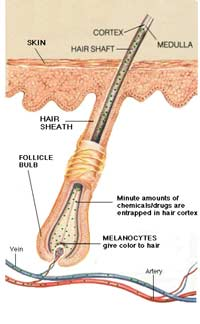

Metabolites or
circulating drugs may be detected in hair. First, these are deposited in the
hair follicle and as the hair grows out, the metabolites will get trapped on
the hair shaft and then in the keratin matrix. Drugs may also enter the hair
through sweat, oil or the external environment. A 3-cm hair specimen may be
able to indicate whether or not the person has been abusing drugs in the past 3
months. It is recommended that the hair specimen must be approximately 1.5 inches
for drug abuse testing. When a person takes a drug, it takes approximately 4 to
5 days for the affected shaft to grow. However, there are a lot of factors that
may affect the levels of the drug incorporated in a person’s hair. This means
that high levels do not necessarily mean a more frequent drug abuse. It was demonstrated by Rothe et al that the doses of administered heroin and the measured concentration of opiates from the hair specimen were not correlated. The drug purity, metabolism, frequency of abuse and hair color are the factors that may affect the drug or metabolite amount incorporated in hair.
Natural hair color is
an important factor in evaluating drug concentration. Drugs or metabolites are
less incorporated in white fibers as compared with the pigmented ones. Melanin
contains eumelanin which is accountable for hair with the colors black or brown
whereas pheomelanin is responsible for red-colored hair. Drugs tend to bind
less to pheomelanin than in eumelanin. Low abuse of drugs might not be detected
in treated hair (e.g. bleached, permed or dyed). However, it can be detected in
regular drug abuse but with reduced concentrations. Bleached or
chemically-treated hair is more at risk to environmental drug uptake. Drugs
already incorporated in hair are less removed in shampooing but this is
effective in removing drugs absorbed from the environment. In hair follicle drug testing, heroin abuse can be detected as long as 90 days prior to testing.
COLLECTION AND TESTING
Hair sample is obtained
and tested under the guidelines of the Society of Hair Testing. First, hair is
thoroughly washed with the use of an organic solvent and with water
subsequently. The washes can also be tested for the presence of the drug and
its metabolites. After washing, the hair is cut into pieces and a small part is
to be tested using Enzyme-linked Immunosorbent Assay (ELISA).
For this test, approximately
50 to 80 strands (45 mg) of hair are needed. There is slight variation due to
hair color, thickness and texture. Samples obtained directly from hair comb or
brush may not be used as samples should be taken live from the patient by
cutting the hair strand as close to the scalp as possible.
ADVANTAGES
·
Hair follicle testing is reliable and
accurate. It is considered to be better than urine testing as some drugs and
their metabolites are easily flushed out of the bloodstream (3-7 days) whereas
drugs trapped in the hair follicle for months to years.
·
It provides complementary information about
the long-term drug abuse history of the patient.
·
Collection is non-invasive and the drugs
incorporated in the hair have longer stability and they are bound for a long
time.
·
Some people try to avoid hair follicle
drug testing by going bald but avoidance is not possible since body hair can be
used as a specimen as well.
· The minimum concentration of metabolites
that can be detected in hair follicle testing is low. Opiates trapped in hair
with a concentration of only 100 pg/mg can be detected by using this test.
·
It can detect the following drugs: Cocaine
(Cocaine & Benzoylecgonine), Marijuana, Opiates (Codeine, Morphine &
6-Monacteyl Morphine), Methamphetamine (Methamphetamine/Amphetamine &
Ecstasy), and Phencyclidine (PCP).
DISADVANTAGES
·
Costly and time-consuming (minimum of 1
month)
·
It should be performed inside the
laboratory
·
There are no available on-site testing
kits
·
It cannot detect very recent drug abuse
(1 to 7 days before testing)












0 comments :
Post a Comment